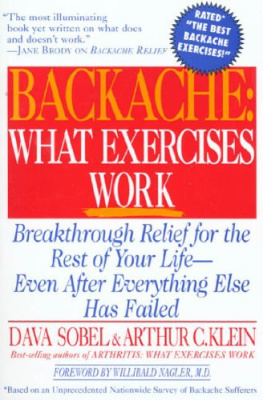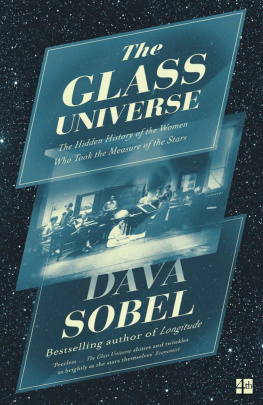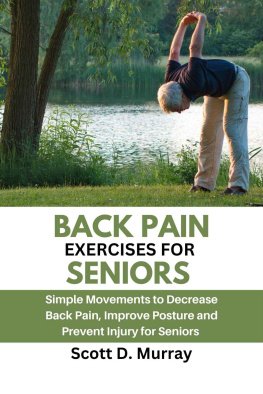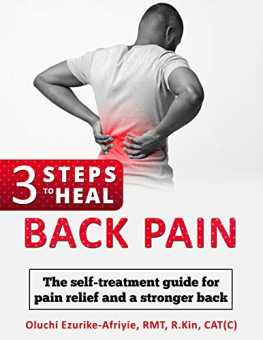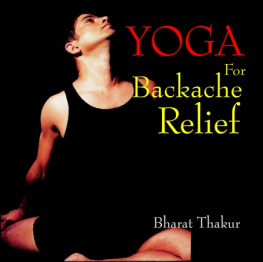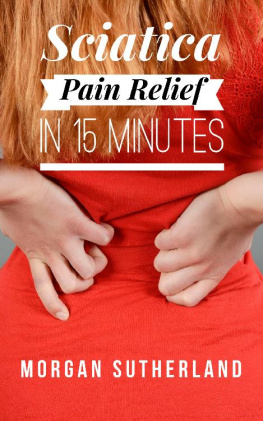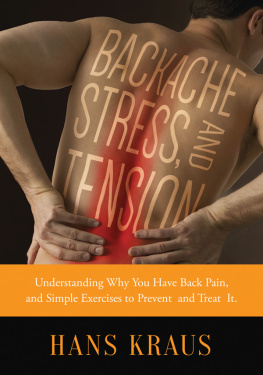ALSO BY DAVA SOBEL AND ARTHUR C. KLEIN
Backache Relief
Arthritis: What Works
Arthritis: What Exercises Work
CHAPTER 1
Exercise by Prescription
Are you in bed? Right this moment, are you suffering spasms of incapacitating back pain? Wondering how long youll have to lie there this time? Worrying about when you can get back to work?
We hope not. But if you are, or if the memory of such an incident is still all too fresh in your mind, we believe this book can give you the help you need to end your episodes of back pain once and for all.
Indeed, the long-awaited, highly touted cure for back painthe treatment that could relieve the agonies of an estimated 80 to 90 percent of the American public and save the country between $16 billion and $50 billion annually in medical expenses and lost work time, according to figures from the American Academy of Orthopdic Surgeonshas actually been discovered. It is called exercise. And it works.
Unfortunately, few people really understand the enormous benefits to be gained from exercise, and even fewer people with back pain, therefore, are willing to invest any time or effort in an exercise program specifically aimed at controlling their painful symptoms. Most of the 80 million people who suffer from periodic bouts of back pain continue to think that there must be a more scientific or perhaps even a surgical solution to their woes. They cannot accept the fact that exercise is simply the best, most potent medicine available to treat a back problem.
We consider this lack of knowledge about exercise a national tragedy. The fact is, as little as ten minutes of exercise a day for two weeks will bring about a striking degree of improvement for most people.
When we undertook our landmark study of back pain, we interviewed individuals from all fifty states who had tried literally everything to lead a full life despite a bad back. Our research exploded many popular misconceptions about back care. We showed, for example, that neither orthopedists nor chiropractors usually made the best back doctors, and that the most widely used treatments for back pain were either ineffective or downright dangerous. We also discovered that the right exercises, performed the right way, were the only key to a pain-free back.
Our recommendations, published in our book Backache Relief, reflected the positive experiences of many survey participants who enjoyed dramatic, long-term relief from back pain, without suffering repeat collapses. What accounted for these individuals successful outcomes? In a word, exercise. The secret to remaining pain-free, they told us, lay in learningand sticking toa well-designed exercise program.
The book in your hands outlines just such a safe, sane exercise program. It gives clear, simple instructions and step-by-step drawings to help you learn the exercise routines with ease. It will also help you devise your own individually tailored exercise program to accomplish any or all of the following goals:
Prevent back problems from plaguing you in the future
Treat a disabling episode of acute pain
Achieve lasting relief from chronic backache
Make lifestyle changes that can put an end to back pain
Our advice and suggestions about exercise are based not only on our own survey research, but also on our continuing review of recent hospital studies investigating the value of exercise for back pain. Numerous studies, completed since the publication of Backache Relief, add further proof that exercise can succeed in helping to alleviate back problemseven after other treatments have failed. Medical researchers all over the world now state confidently that a combination of aerobic, stretching, strengthening, and endurance exercises can bring about genuine improvement for most painful back conditions. Instead of dismissing back pain as the price we pay for walking upright, specialists are at last coming to see back pain as the consequence of not walking upright enough of spending too much time sitting at the desk, in front of the television, or behind the wheel.
For example, a recent study conducted at the University of Copenhagen, divided 105 patients with chronic low-back pain into three groups. One group underwent three months of intensive exercise training, which entailed thirty workout sessions. The second group attended just as many sessions in the gym, but were asked to perform only a fraction of the activity. The third group had the most sedentary time of all, performing some mild exercise at their sessions, but spending more time receiving heat treatments and massage.
As the doctors reported in 1991 in the journal Pain, the subjects in the active-exercise group who continued in training at least once a week over the follow-up year were in the best shape, with less pain and greater mobility than they had at the studys outset. The positive result held as true for women as for men, regardless of age. The researchers also noted that the patients preexisting conditions had little bearing on their improvement. Indeed, even some veterans of chronic back syndromes got better as a result of the increased activity.
The program we offer in this book is neither rigorous nor difficult. Some of the exercises may seem no more strenuous to you than an everyday activity such as getting out of bed or shopping for your groceries. Yet the simple act of stretching your legs and strengthening your abdominal muscles will have profound effects on the way you look and feel. A small amount of effort will pay off in a noticeable improvement in well-being.
More validation for exercise emerged from a study at Swedens Sahlgren Hospital. The participants there included 103 industrial workers who had been out of work for eight weeks because of low-back pain. The doctors instructed half of this group in gentle, individually tailored exercises and safety tips for avoiding injury. Not surprisingly, this half wound up going back to work sooner, feeling better. Over the ensuing year, those who exercised and watched their backs lost fewer work days than others who did not learn such precautions, according to the researchers 1992 report in the journal Physical Therapy.
In the United States, where back pain accounts for 40 to 50 percent of all lost work days, and as many as one-third of all workers compensation payments, employees in all sorts of industrial and office settings could be helped by performing exercises at home and learning the back-kindest ways to go about their jobs. You will find tips of this sort in chapters 14, 15, and 16.
When medical studies compare exercise to no exercise, few researchers are surprised to find that the exercise effort paid off in terms of pain relief. Other studies we reviewed went even further in establishing the importance of exerciseby comparing exercise to other widely used treatments for back pain. For example, Dr. Richard A. Deyo of the University of Washington School of Medicine and School of Public Health has tested exercise against transcutaneous electrical nerve stimulation, called TENS. In treatment, the TENS device, about the size of a television remote control, is hooked up to the patients back via wires and electrodes that gently and steadily jolt the areas of muscle spasm. The electric current is said to confer relaxation and relief. Our own investigation of TENS had convinced us that the units workedat most50 percent of the time.
For his research project, Dr. Deyo gave each of his subjects either a real TENS device or a sham TENS unit that gave no jolt but looked like a working machine. Since he never told patients of the differences, each expected some help to come from the little machine. At the same time, Dr. Deyo also put several of the participants on a program of stretching exercise to be performed in addition to the TENS treatments. After one month, the subjects who had exercised were better off than those who hadnt, regardless of whether they had the real or false TENS units. Only the exercise proved valuable. But the subjects didnt seem to understand the connection. Despite the improvement, most of them had quit exercising by the time of the follow-up exam two months laterand their pain had returned.
Next page
